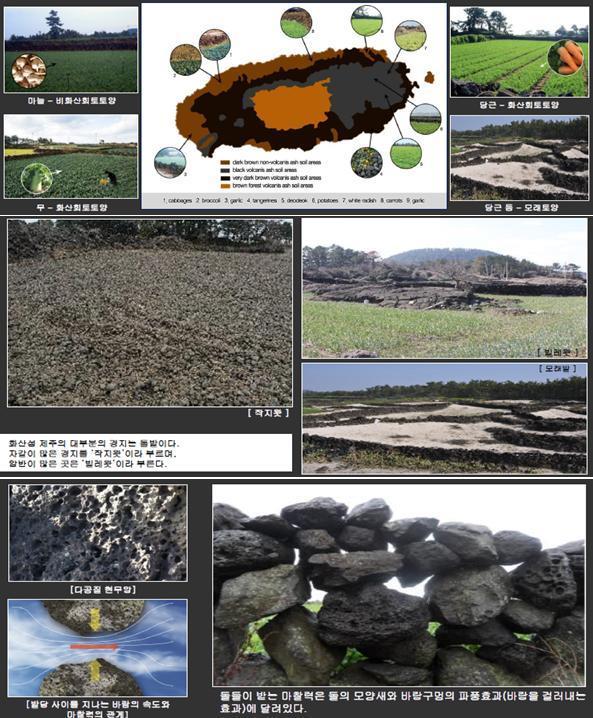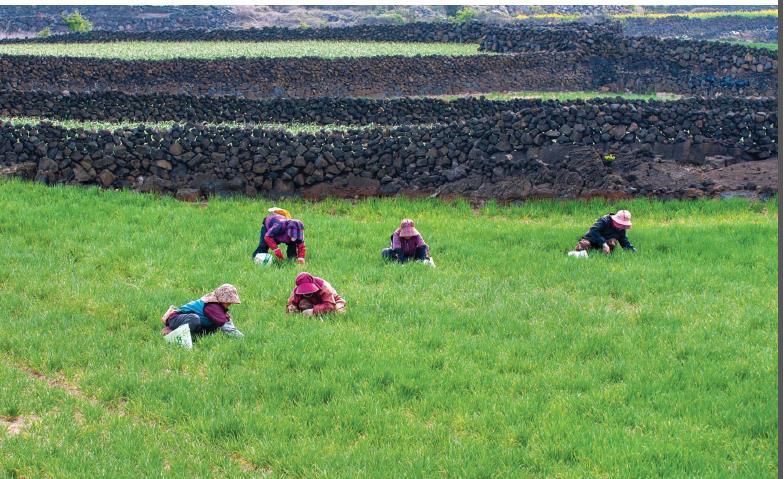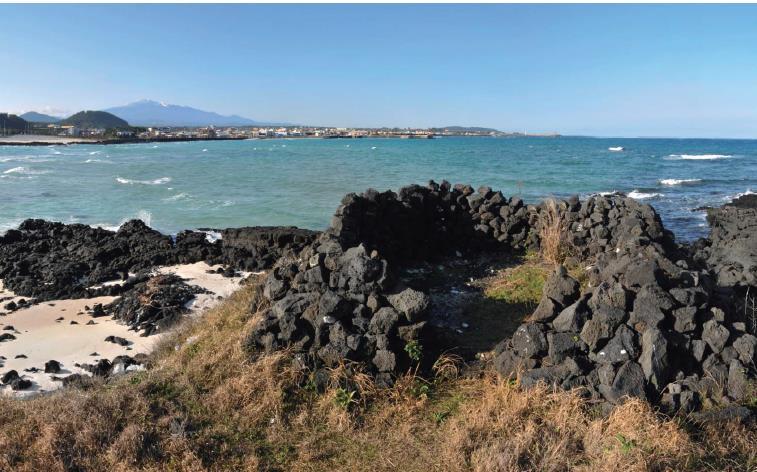
11 minute read
Ⅳ Old Future through Jeju Batdam Agricultural system
island.
Jeju Batdam agricultural system has great significance in terms of social and cultural aspects. It
Advertisement
supported islanders’ survival while being a trace of mankind’s survival against barren environments. As
one of the unique heritage, reflecting coexistence between mankind and nature, it offers Jejupeople’s
pioneer spirit and wisdom. It also will function as the core cord for Jejutourism in future. It can be a core
theme for cultural tourism, agri-tourism and onsite experience tourism. The entangled Jeju Batdam
agricultural system in continuous curves would hold itself but with one spot collapsing the whole fence
may fall as a result. It always had to stay as one unit, and that spirit resembles Jejupeople’s spirit, too
Ⅱ. Structure and Patterns of Jeju Batdam
What would be the distinct features of Batdam agricultural system? The true beauty of Jeju
Batdamagricultural system may be the reflection of Jejupeople’s wisdom through its exterior
beauty. Batdam agricultural system has set boundaries of ownership and also has been a
cultural production, revealing ancestors’ will and wisdom to protect their crop and soil.
Jeju Batdam has been constructed by individuals or family members and didn’t necessarily
require of a master craftsman to interlock and pile the rocks. It holds the simplest structure
and is simple to restore. That doesn’t mean anybody can build and maintain it. Various
experiences and long time learning is required to train an expert for Jeju Batdam agricultural
system building. Skills to place base rock, skills to pile rocks in stagger angle and skills to
locate right angle to push down and pile a rock in the right place can only come from enough
experiences. Jeju Batdam agricultural system construction requires highly trained technique
from real time experiences to pile rocks in interlocking positions with certain wholes between
and with balancing wind flow.
Rock sizes for Jeju Batdam agricultural system include big, small, tall, flat, angulated and
round. Each piece of rocks can have its own function. Jeju Batdam in big size rocks may hold
weight while missing an interlocking piece. And the big size rock may not survive strong
winds with larger exposure to wind. However, combination of big and small rocks may serve
its interlocking position and be a strong fence. Even one side of Jeju Batdam agricultural
system falls, no entire fence will collapse. The fallen part of it can be fixed easily and that is
one of structural features of Batdamagricultural system.
Different shapes of rock in Jeju Batdam agricultural system may be reflected according to
its shape being exposed to. Streamlined shape rocks may face less strength from wind. That
doesn’t explain how Jeju Batdam agricultural system in hilly sides survived all these years.
We can think about frictional force. Basalt rocks in it may hold air holes. So the contact
surface is very rough. Jeju Batdamagricultural system is built, placing an upper rock between
two lower rocks. The reduction of normal force can reduce frictional force. The effected
force in lower rocks was dispersed in this direction by upper rocks.
Gaps, rocks surface and relation with wind speed in it is another main factor to hold itself.
The wind passes much faster in gaps of Jeju Batdam agricultural system than nearby air,
causing lower pressure, and difference force effect through the direction of gaps. The force
to press rocks toward gaps and the vertical force at surfaces of rocks can increase normal
force coefficient, increasing frictional force. The key factors for loose Jeju Batdam
agricultural system to stay strong against winds include rock shape, frictional force of rocks
and holes between rocks. The structure of Jeju Batdam agricultural system is streamlined
with good air resistance and higher frictional force form basalt rocks with air holes. Unlike
other fences, enormous holes allowing easy air passes with reduced resistance, Jeju Batdam
can hold itself better. This can explain the secret for Jeju Batdam agricultural system’s long
survival.

Patterns of Jeju Batdam Agricultural System
1.
2. 3.
잣담 : 잣길/Jatdam or Jatgil : Farmers used to walk on the fence, Jatgil that is a thoughtful way of helping neighbors having land with no roads. 머들/Meodeul : piled-up stones during the cultivation 올레와 우영팟/Olle (entrance of a village) and
Soils thru various periods of volcanic
activities and climate differences per
distinctive regions have effected
Uyeongpat (a vegetable garden near a house surrounded by Batdam)
various agricultural environments in
Jeju. Jeju soil can be separated into two types, including non-volcanic-ash-soil in northwestern
coasts of island and volcanic-ash-soil- in northeast and hilly side of island. Mt. Halla and
Kurusio Sea Current cause climate differences between east to west and south to north of island.
Jeju’s Batdamagricultural system differ from each region of island for that reason.
It is divided per its structure into 4 types, including Oidam, Jeopdam, Jatdam and Japgupdam.
Oidam is most common and built in single-line. Jeopdammeans double layered Jeju Batdamagricultural
system, and found in farmlands in rocker fields. Jatdam or Jatbaekdamis built as a wider scale of castle fence,
and this type was built during continuous digging of rocks from farmlands. Jatdamalso allowed passes of
neighboring farmers without a path to his farmland from the main road, reflecting ancestors’ compassion and
care for others. The unique Japgutdamholds smaller rocks at bottom and bigger ones on top.
But again it is difficult to identify all Jeju Batdamagricultural system into these categories only for each of it
reflects various features of its location. Jeju Batdamagricultural system around Seoldeok or Billeshows good
example of wise utilization of environment. Some Jeju Batdamagricultural systems in hilly areas are utilized for
border purpose only. It represents the long survival of Jeju agriculture against barren environments and
changes.
Ⅲ. Stone Cultures & Agricultural Cultures
Stone Cultures of Jeju
Stone has been one of most important and critical resources for mankind on planet earth.
Stone was the most used resource through Old Stone Age, New Stone Age then expanded
with much wider scope of usage post historical Period. This situation applies same in Korea
and Jeju, too. Stone was included in fortresses, constructions, weapons and living tools from
the epoch of the three Kingdoms, and stone was an inevitable resource for economic
activities, including agriculture, fishery and ranching. It is fair to estimate people’s life was
impossible without stone resource before Jeju entered modern period. It is natural
production of wisdom to utilize stone resource in the totally isolated marginal island Jeju.
Fortunately, island Jeju was blessed with enormous amount of rocks from volcanic
activities.
Life in barren environment with insufficient resources was improved by stone resource.
The fundamental background for advanced stone cultures of Jeju lies in clear understanding
of barren environment together with wisdom of Jeju ancestors. Ancestors of Jeju utilize
stones for various causes like construction, producing, life and games, including Sandam,
Wondam, Wuldam, Olletdam, Seongdam, Dongjaseok, Dolhareubang, Bulpand, banga and
Deumdol.

Agricultural Cultures in Jeju
One of Jeju culture called Suneulem allows labor exchange for hard work. Jeju’s barren
agricultural environment didn’t allow farming without the structure of community spirit.
The hardest tasks of 3 to 4 times of weeding per season required most hands. And
weeding as labor exchange and help still continues in Jeju. Besides the labor exchange for
farming, thatched roof construction and family occasions are handled with help of neighbors
and returning is offered when a same case occurs with neighbors. These culture continued
in consideration for neighbors, and the farmer at the road side harvest first then inner
farmland farmer would go through the harvested farmland to harvest his. Jatkil show such
consideration for neighbors.
Different soil fertility created cultural differences. Soil fertility effects agricultural
productivity and life style. Soil fertility has influenced Jeju’s culture and custom variously
and they are memorial service style, melody of work song, historic sites and distribution of
dolmen, Sanpa (sawing) and furrow cultivation. Bunjitgeori jesa (memorial service) was
practiced in the rich dark brown non-volcanic-ash-soil while eldest son hosted memorial
services in volcanic-ash-soil area. Western area with richer soil handled rice and barley
cultivation and inherited divided land and duty of memorial services. But in eastern part with
volcanic-ash-soil, land share couldn’t allow self-support of food and only eldest son
inherited family land and duty of memorial service as a consequence Distribution of historic
sites and dolmen also depends on soil fertility. Historic sites and dolmen are only found in
non-volcanic-ash-soil, indicating dwellings were settled around richer soil coast areas from
prehistoric period.

Work song melody shows differences, too.
‘Weeding song’
in volcanic-ash-soil area is sad and
include Jin(long)-sa-daet-so-ri of long shamanistic chorus while Jjol-leun(short)-sa-daet-so-riwas
sang in richer non- volcanic-ash-soil area. Sawing methods show differences per soil features and
regions. For rain can easily ruin the well-made furrows in volcanic-ash-soil area, sprinkle
sawing is practiced while furrow sawing fashion was practiced in non- volcanic-ash-soil area.
Sawing in Jeju also holds further significance. All sawing is done with sprinkling sawing except
bug wheat with sawing and spot sawing. Distance between nursery plants is different per
characteristics of each plant, and the distance is usually determined during first weeding. Under
developed plants are taken out thru weeding. Farmer can control the distance between sprouts
by transferring sprouted nursery plant to the area with less sprouting. It was the last resort to
select out strong plant from high density sprinkle sawing in the poor soil condition. Farmlands in
hilly areas include Moneulpot(bugwheat field), Saewat (DDeuibat) for thatched roofs. Mujangjeon
in the hilly area means farmland without stone fences. Ranching and farming have been
developed in Jeju together. Strength of horse and cow were required to ship heavy-farm
produce and plowing. Ranching is the companion of agriculture in Jeju. Horses and cows
provided labor forces, manure and quality food during the undernourishment era. Horses and
cows were blocked off from field-breaking with Jeju Batdamagricultural system built in Dambat
but field-breaking was a big worry in Mujangjeon area with no fence built. Kemaegi community
managing party per district or village level was formed as a result. ‘Ke’ indicates a district of
field or farmland in the district while ‘Maegi’ is a Jeju dialect for collection. Manager Gamgwan
manages each Ke unit. Kemaegi culture lasted till 1970s around villages in hilly sides and
Gosan-ri in Hangyoung-meon where rice farming is practiced, and that is one distinctive
agricultural culture for areas without Batdamagricultural system.


The life force of Jeju Batdam agricultural system is still ongoing with agricultural
activities. Horses and cows were grazed in mountains and fields up until 1960s, and self
support agriculture with barley, millet and sweet potato is still active utilizing cattle. With
that background, Jeju Batdam agricultural system has changed its looks a great deal in
recent days. The speedy changes took place with mechanization of agriculture, introduction
of scientific farming, changes of cultivation crops in 1970s, urbanization and development of
stone processing techniques.
Mechanization of agriculture and introduction of scientific farming reduced gradually the
functions and benefits of Jeju Batdam agricultural system. Its curved shape makes it harder
to adapt the machine usage. A few areas readjusted the farmlands. Unstandardized
farmlands were readjusted, and Jeju Batdam were removed for practical machine uses. The
increase of green house cultivation also reduced the role of it, only left it as a border.


해신당(Haesindang: shrine of the sea god)과 밭담(Jeju Batdam)


원(Won (or Wondam): fishing facility of stones)

불턱(Bulteok: a dressing place for Jomnyeo(Haenyeo), female diver
Beginning of citrus cultivation in 1960s leaded the unavoidable changes to Jeju Batdam
agriculture system. The new citrus fields were formed in the existing pasture or farmlands
of barley and sweet potatoes. Citrus became the main agricultural product of Jeju in 1970s,
changing Jeju Batdam agricultural system to some extent. Strong winds of Jeju needed to be
blocked off for successful citrus cultivation. The average height of stone fences became
higher and stone masons in Seogwipo region were busy, meeting the demand of the new
type of stone walls. However, it was not easy work to build the stone fence much higher to
fit for the wind-breaking purpose. That’s why cedar trees were planted around stone
fences, forming the better wind belts. And with the appearance of the newest artificial
wind-break facility, the height of stone fence became lower again.
Urbanization also has changed images of Jeju Batdam seriously. Various urban facilities
were built in rural areas. Roads around cities removed stone fences and blocked off the ties
of Jeju Batdam agricultural system with rural areas. Majority of Jeju Batdam agricultural
system is still survived now. However, the resent stone fences around roads are built by
stone masons in a high density design unlike Jeju Batdam agricultural system with many
holes. Technical advancement in recent 30~40 years and changes in Jeju agriculture have
effected Jeju Batdam agricultural system a great deal. However, it still represents Jeju’s
cultural landscapes. And boundary stone fences still continue its role as a valued long
lasting cultural heritage.


